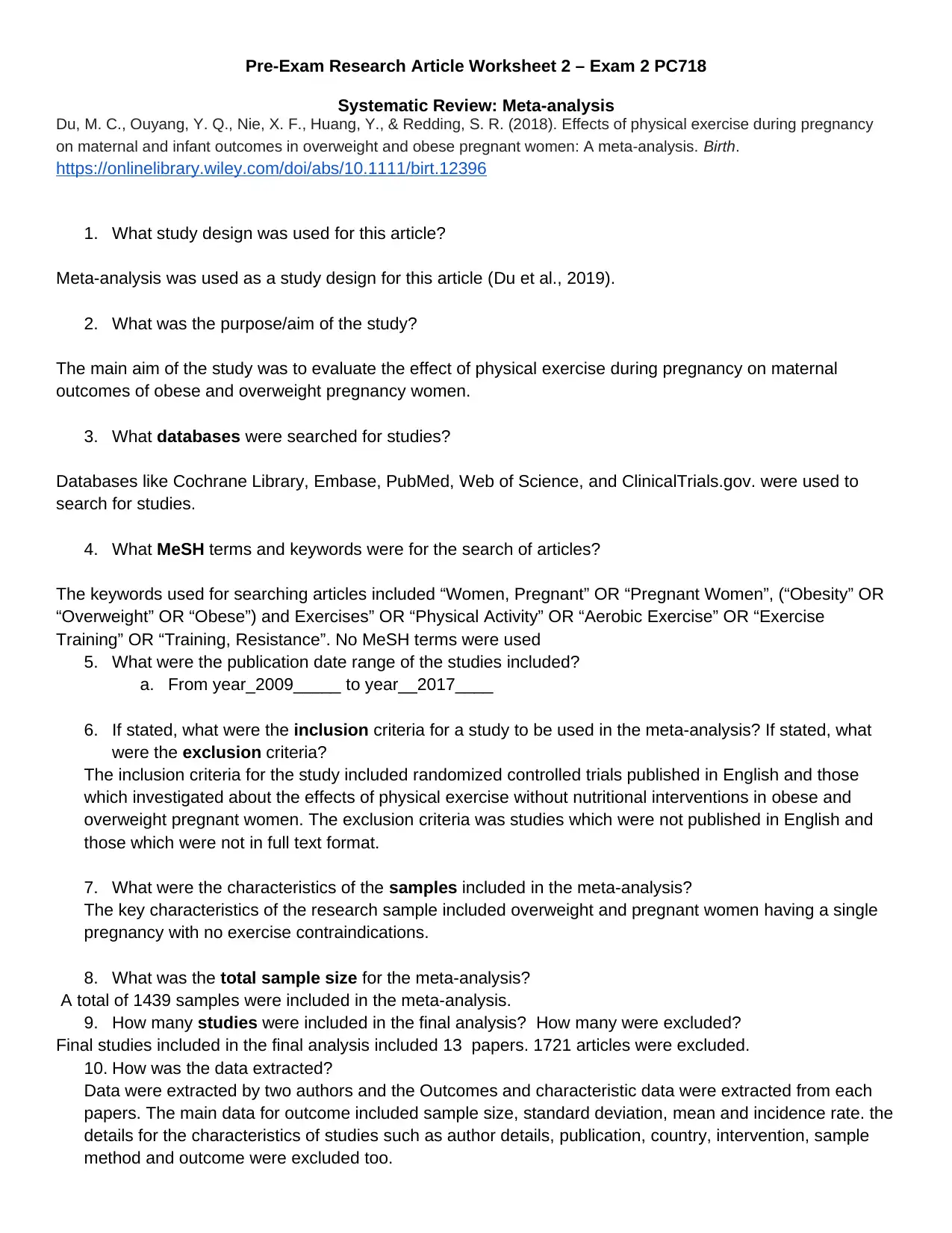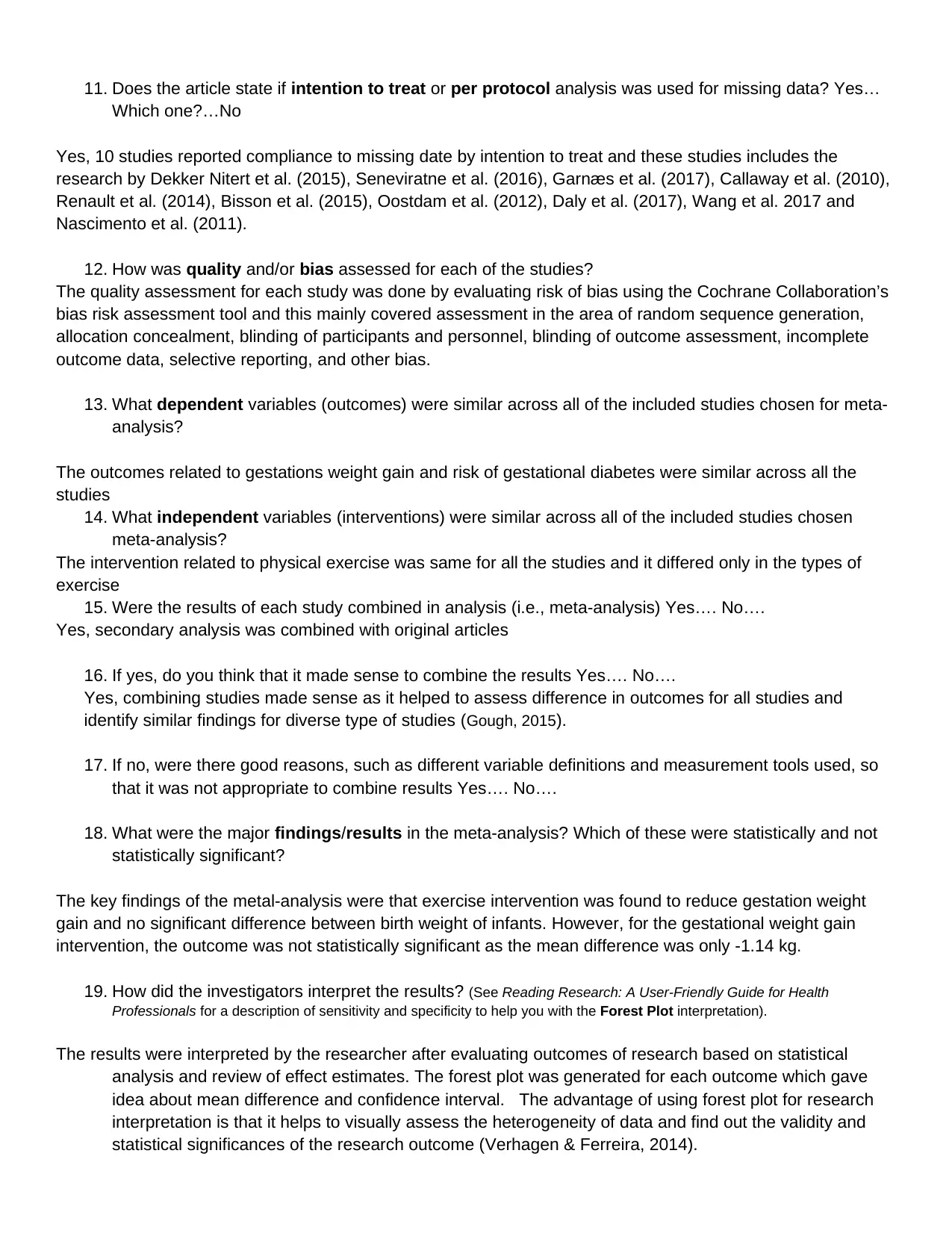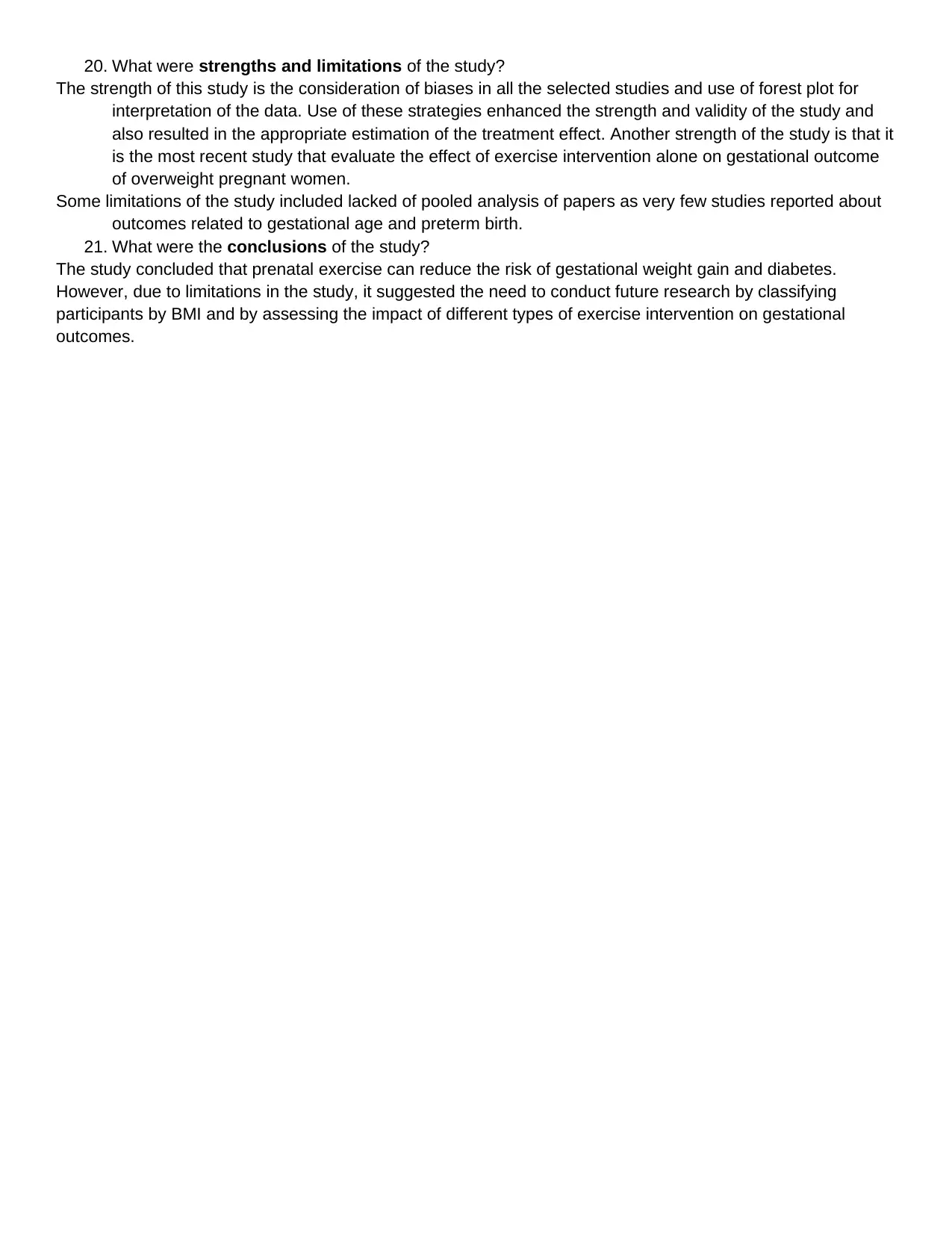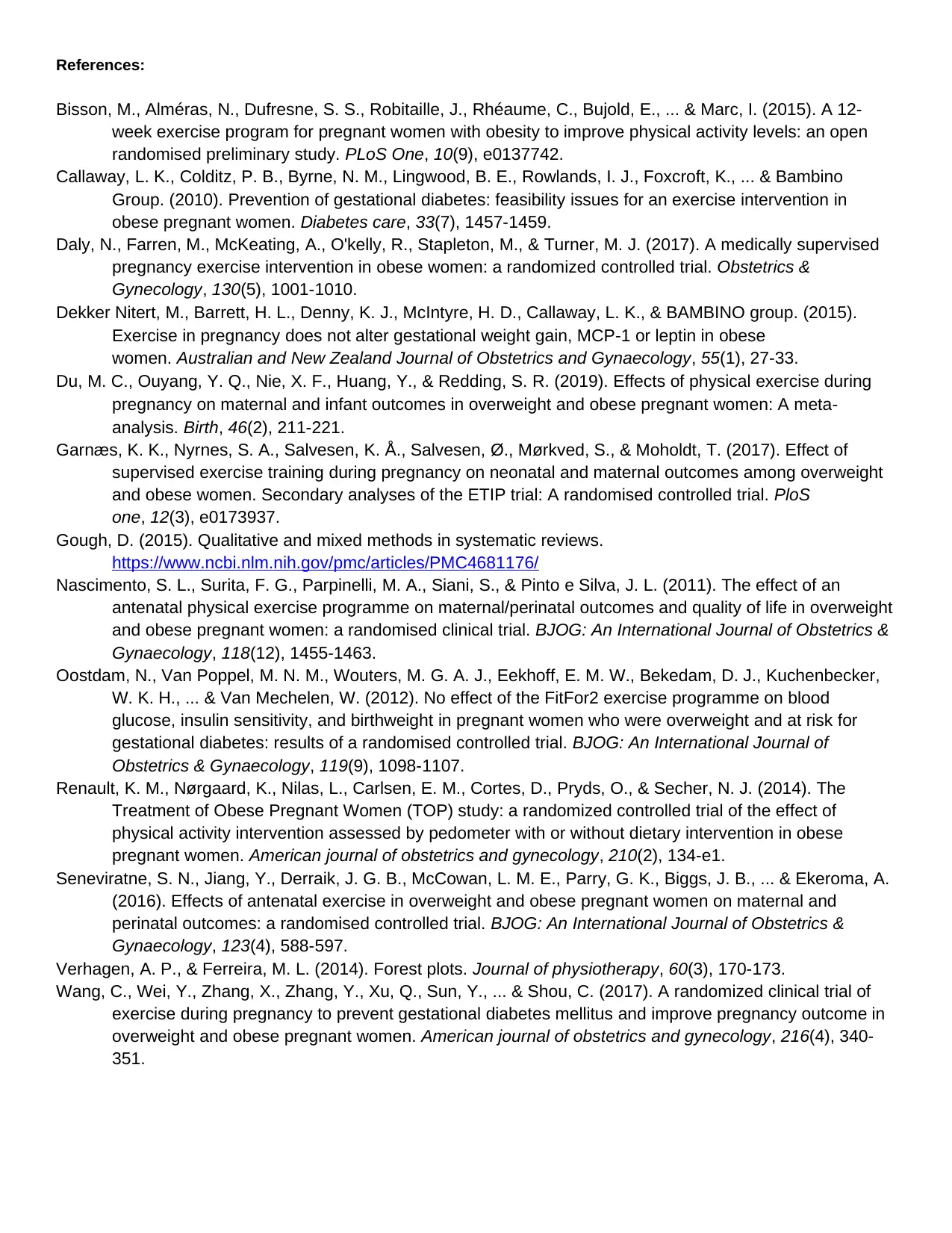PC718: Systematic Review Research Article Worksheet - Exam 2 Analysis
VerifiedAdded on 2022/09/17
|4
|2056
|23
Homework Assignment
AI Summary
This homework assignment is a detailed worksheet analyzing a meta-analysis research article by Du et al. (2018) on the effects of physical exercise during pregnancy on maternal and infant outcomes in overweight and obese pregnant women. The assignment covers the study design (meta-analysis), purpose (evaluate exercise effects), databases searched (Cochrane Library, Embase, etc.), keywords, inclusion/exclusion criteria, sample characteristics (overweight pregnant women), sample size (1439), number of studies included (13), data extraction methods, and assessment of quality and bias (Cochrane Collaboration tool). The assignment further explores the dependent and independent variables, the combination of study results in the meta-analysis, major findings (reduced gestational weight gain, no significant difference in infant birth weight), interpretations, strengths (consideration of bias, forest plot use), limitations (lack of pooled analysis for some outcomes), and conclusions (prenatal exercise reduces gestational weight gain and diabetes risk). The analysis includes references to the original research article and related studies.

Pre-Exam Research Article Worksheet 2 – Exam 2 PC718
Systematic Review: Meta-analysis
Du, M. C., Ouyang, Y. Q., Nie, X. F., Huang, Y., & Redding, S. R. (2018). Effects of physical exercise during pregnancy
on maternal and infant outcomes in overweight and obese pregnant women: A meta‐analysis. Birth.
https://onlinelibrary.wiley.com/doi/abs/10.1111/birt.12396
1. What study design was used for this article?
Meta-analysis was used as a study design for this article (Du et al., 2019).
2. What was the purpose/aim of the study?
The main aim of the study was to evaluate the effect of physical exercise during pregnancy on maternal
outcomes of obese and overweight pregnancy women.
3. What databases were searched for studies?
Databases like Cochrane Library, Embase, PubMed, Web of Science, and ClinicalTrials.gov. were used to
search for studies.
4. What MeSH terms and keywords were for the search of articles?
The keywords used for searching articles included “Women, Pregnant” OR “Pregnant Women”, (“Obesity” OR
“Overweight” OR “Obese”) and Exercises” OR “Physical Activity” OR “Aerobic Exercise” OR “Exercise
Training” OR “Training, Resistance”. No MeSH terms were used
5. What were the publication date range of the studies included?
a. From year_2009_____ to year__2017____
6. If stated, what were the inclusion criteria for a study to be used in the meta-analysis? If stated, what
were the exclusion criteria?
The inclusion criteria for the study included randomized controlled trials published in English and those
which investigated about the effects of physical exercise without nutritional interventions in obese and
overweight pregnant women. The exclusion criteria was studies which were not published in English and
those which were not in full text format.
7. What were the characteristics of the samples included in the meta-analysis?
The key characteristics of the research sample included overweight and pregnant women having a single
pregnancy with no exercise contraindications.
8. What was the total sample size for the meta-analysis?
A total of 1439 samples were included in the meta-analysis.
9. How many studies were included in the final analysis? How many were excluded?
Final studies included in the final analysis included 13 papers. 1721 articles were excluded.
10. How was the data extracted?
Data were extracted by two authors and the Outcomes and characteristic data were extracted from each
papers. The main data for outcome included sample size, standard deviation, mean and incidence rate. the
details for the characteristics of studies such as author details, publication, country, intervention, sample
method and outcome were excluded too.
Systematic Review: Meta-analysis
Du, M. C., Ouyang, Y. Q., Nie, X. F., Huang, Y., & Redding, S. R. (2018). Effects of physical exercise during pregnancy
on maternal and infant outcomes in overweight and obese pregnant women: A meta‐analysis. Birth.
https://onlinelibrary.wiley.com/doi/abs/10.1111/birt.12396
1. What study design was used for this article?
Meta-analysis was used as a study design for this article (Du et al., 2019).
2. What was the purpose/aim of the study?
The main aim of the study was to evaluate the effect of physical exercise during pregnancy on maternal
outcomes of obese and overweight pregnancy women.
3. What databases were searched for studies?
Databases like Cochrane Library, Embase, PubMed, Web of Science, and ClinicalTrials.gov. were used to
search for studies.
4. What MeSH terms and keywords were for the search of articles?
The keywords used for searching articles included “Women, Pregnant” OR “Pregnant Women”, (“Obesity” OR
“Overweight” OR “Obese”) and Exercises” OR “Physical Activity” OR “Aerobic Exercise” OR “Exercise
Training” OR “Training, Resistance”. No MeSH terms were used
5. What were the publication date range of the studies included?
a. From year_2009_____ to year__2017____
6. If stated, what were the inclusion criteria for a study to be used in the meta-analysis? If stated, what
were the exclusion criteria?
The inclusion criteria for the study included randomized controlled trials published in English and those
which investigated about the effects of physical exercise without nutritional interventions in obese and
overweight pregnant women. The exclusion criteria was studies which were not published in English and
those which were not in full text format.
7. What were the characteristics of the samples included in the meta-analysis?
The key characteristics of the research sample included overweight and pregnant women having a single
pregnancy with no exercise contraindications.
8. What was the total sample size for the meta-analysis?
A total of 1439 samples were included in the meta-analysis.
9. How many studies were included in the final analysis? How many were excluded?
Final studies included in the final analysis included 13 papers. 1721 articles were excluded.
10. How was the data extracted?
Data were extracted by two authors and the Outcomes and characteristic data were extracted from each
papers. The main data for outcome included sample size, standard deviation, mean and incidence rate. the
details for the characteristics of studies such as author details, publication, country, intervention, sample
method and outcome were excluded too.
Paraphrase This Document
Need a fresh take? Get an instant paraphrase of this document with our AI Paraphraser

11. Does the article state if intention to treat or per protocol analysis was used for missing data? Yes…
Which one?…No
Yes, 10 studies reported compliance to missing date by intention to treat and these studies includes the
research by Dekker Nitert et al. (2015), Seneviratne et al. (2016), Garnæs et al. (2017), Callaway et al. (2010),
Renault et al. (2014), Bisson et al. (2015), Oostdam et al. (2012), Daly et al. (2017), Wang et al. 2017 and
Nascimento et al. (2011).
12. How was quality and/or bias assessed for each of the studies?
The quality assessment for each study was done by evaluating risk of bias using the Cochrane Collaboration’s
bias risk assessment tool and this mainly covered assessment in the area of random sequence generation,
allocation concealment, blinding of participants and personnel, blinding of outcome assessment, incomplete
outcome data, selective reporting, and other bias.
13. What dependent variables (outcomes) were similar across all of the included studies chosen for meta-
analysis?
The outcomes related to gestations weight gain and risk of gestational diabetes were similar across all the
studies
14. What independent variables (interventions) were similar across all of the included studies chosen
meta-analysis?
The intervention related to physical exercise was same for all the studies and it differed only in the types of
exercise
15. Were the results of each study combined in analysis (i.e., meta-analysis) Yes…. No….
Yes, secondary analysis was combined with original articles
16. If yes, do you think that it made sense to combine the results Yes…. No….
Yes, combining studies made sense as it helped to assess difference in outcomes for all studies and
identify similar findings for diverse type of studies (Gough, 2015).
17. If no, were there good reasons, such as different variable definitions and measurement tools used, so
that it was not appropriate to combine results Yes…. No….
18. What were the major findings/results in the meta-analysis? Which of these were statistically and not
statistically significant?
The key findings of the metal-analysis were that exercise intervention was found to reduce gestation weight
gain and no significant difference between birth weight of infants. However, for the gestational weight gain
intervention, the outcome was not statistically significant as the mean difference was only -1.14 kg.
19. How did the investigators interpret the results? (See Reading Research: A User-Friendly Guide for Health
Professionals for a description of sensitivity and specificity to help you with the Forest Plot interpretation).
The results were interpreted by the researcher after evaluating outcomes of research based on statistical
analysis and review of effect estimates. The forest plot was generated for each outcome which gave
idea about mean difference and confidence interval. The advantage of using forest plot for research
interpretation is that it helps to visually assess the heterogeneity of data and find out the validity and
statistical significances of the research outcome (Verhagen & Ferreira, 2014).
Which one?…No
Yes, 10 studies reported compliance to missing date by intention to treat and these studies includes the
research by Dekker Nitert et al. (2015), Seneviratne et al. (2016), Garnæs et al. (2017), Callaway et al. (2010),
Renault et al. (2014), Bisson et al. (2015), Oostdam et al. (2012), Daly et al. (2017), Wang et al. 2017 and
Nascimento et al. (2011).
12. How was quality and/or bias assessed for each of the studies?
The quality assessment for each study was done by evaluating risk of bias using the Cochrane Collaboration’s
bias risk assessment tool and this mainly covered assessment in the area of random sequence generation,
allocation concealment, blinding of participants and personnel, blinding of outcome assessment, incomplete
outcome data, selective reporting, and other bias.
13. What dependent variables (outcomes) were similar across all of the included studies chosen for meta-
analysis?
The outcomes related to gestations weight gain and risk of gestational diabetes were similar across all the
studies
14. What independent variables (interventions) were similar across all of the included studies chosen
meta-analysis?
The intervention related to physical exercise was same for all the studies and it differed only in the types of
exercise
15. Were the results of each study combined in analysis (i.e., meta-analysis) Yes…. No….
Yes, secondary analysis was combined with original articles
16. If yes, do you think that it made sense to combine the results Yes…. No….
Yes, combining studies made sense as it helped to assess difference in outcomes for all studies and
identify similar findings for diverse type of studies (Gough, 2015).
17. If no, were there good reasons, such as different variable definitions and measurement tools used, so
that it was not appropriate to combine results Yes…. No….
18. What were the major findings/results in the meta-analysis? Which of these were statistically and not
statistically significant?
The key findings of the metal-analysis were that exercise intervention was found to reduce gestation weight
gain and no significant difference between birth weight of infants. However, for the gestational weight gain
intervention, the outcome was not statistically significant as the mean difference was only -1.14 kg.
19. How did the investigators interpret the results? (See Reading Research: A User-Friendly Guide for Health
Professionals for a description of sensitivity and specificity to help you with the Forest Plot interpretation).
The results were interpreted by the researcher after evaluating outcomes of research based on statistical
analysis and review of effect estimates. The forest plot was generated for each outcome which gave
idea about mean difference and confidence interval. The advantage of using forest plot for research
interpretation is that it helps to visually assess the heterogeneity of data and find out the validity and
statistical significances of the research outcome (Verhagen & Ferreira, 2014).

20. What were strengths and limitations of the study?
The strength of this study is the consideration of biases in all the selected studies and use of forest plot for
interpretation of the data. Use of these strategies enhanced the strength and validity of the study and
also resulted in the appropriate estimation of the treatment effect. Another strength of the study is that it
is the most recent study that evaluate the effect of exercise intervention alone on gestational outcome
of overweight pregnant women.
Some limitations of the study included lacked of pooled analysis of papers as very few studies reported about
outcomes related to gestational age and preterm birth.
21. What were the conclusions of the study?
The study concluded that prenatal exercise can reduce the risk of gestational weight gain and diabetes.
However, due to limitations in the study, it suggested the need to conduct future research by classifying
participants by BMI and by assessing the impact of different types of exercise intervention on gestational
outcomes.
The strength of this study is the consideration of biases in all the selected studies and use of forest plot for
interpretation of the data. Use of these strategies enhanced the strength and validity of the study and
also resulted in the appropriate estimation of the treatment effect. Another strength of the study is that it
is the most recent study that evaluate the effect of exercise intervention alone on gestational outcome
of overweight pregnant women.
Some limitations of the study included lacked of pooled analysis of papers as very few studies reported about
outcomes related to gestational age and preterm birth.
21. What were the conclusions of the study?
The study concluded that prenatal exercise can reduce the risk of gestational weight gain and diabetes.
However, due to limitations in the study, it suggested the need to conduct future research by classifying
participants by BMI and by assessing the impact of different types of exercise intervention on gestational
outcomes.
⊘ This is a preview!⊘
Do you want full access?
Subscribe today to unlock all pages.

Trusted by 1+ million students worldwide

References:
Bisson, M., Alméras, N., Dufresne, S. S., Robitaille, J., Rhéaume, C., Bujold, E., ... & Marc, I. (2015). A 12-
week exercise program for pregnant women with obesity to improve physical activity levels: an open
randomised preliminary study. PLoS One, 10(9), e0137742.
Callaway, L. K., Colditz, P. B., Byrne, N. M., Lingwood, B. E., Rowlands, I. J., Foxcroft, K., ... & Bambino
Group. (2010). Prevention of gestational diabetes: feasibility issues for an exercise intervention in
obese pregnant women. Diabetes care, 33(7), 1457-1459.
Daly, N., Farren, M., McKeating, A., O'kelly, R., Stapleton, M., & Turner, M. J. (2017). A medically supervised
pregnancy exercise intervention in obese women: a randomized controlled trial. Obstetrics &
Gynecology, 130(5), 1001-1010.
Dekker Nitert, M., Barrett, H. L., Denny, K. J., McIntyre, H. D., Callaway, L. K., & BAMBINO group. (2015).
Exercise in pregnancy does not alter gestational weight gain, MCP‐1 or leptin in obese
women. Australian and New Zealand Journal of Obstetrics and Gynaecology, 55(1), 27-33.
Du, M. C., Ouyang, Y. Q., Nie, X. F., Huang, Y., & Redding, S. R. (2019). Effects of physical exercise during
pregnancy on maternal and infant outcomes in overweight and obese pregnant women: A meta‐
analysis. Birth, 46(2), 211-221.
Garnæs, K. K., Nyrnes, S. A., Salvesen, K. Å., Salvesen, Ø., Mørkved, S., & Moholdt, T. (2017). Effect of
supervised exercise training during pregnancy on neonatal and maternal outcomes among overweight
and obese women. Secondary analyses of the ETIP trial: A randomised controlled trial. PloS
one, 12(3), e0173937.
Gough, D. (2015). Qualitative and mixed methods in systematic reviews.
https://www.ncbi.nlm.nih.gov/pmc/articles/PMC4681176/
Nascimento, S. L., Surita, F. G., Parpinelli, M. A., Siani, S., & Pinto e Silva, J. L. (2011). The effect of an
antenatal physical exercise programme on maternal/perinatal outcomes and quality of life in overweight
and obese pregnant women: a randomised clinical trial. BJOG: An International Journal of Obstetrics &
Gynaecology, 118(12), 1455-1463.
Oostdam, N., Van Poppel, M. N. M., Wouters, M. G. A. J., Eekhoff, E. M. W., Bekedam, D. J., Kuchenbecker,
W. K. H., ... & Van Mechelen, W. (2012). No effect of the FitFor2 exercise programme on blood
glucose, insulin sensitivity, and birthweight in pregnant women who were overweight and at risk for
gestational diabetes: results of a randomised controlled trial. BJOG: An International Journal of
Obstetrics & Gynaecology, 119(9), 1098-1107.
Renault, K. M., Nørgaard, K., Nilas, L., Carlsen, E. M., Cortes, D., Pryds, O., & Secher, N. J. (2014). The
Treatment of Obese Pregnant Women (TOP) study: a randomized controlled trial of the effect of
physical activity intervention assessed by pedometer with or without dietary intervention in obese
pregnant women. American journal of obstetrics and gynecology, 210(2), 134-e1.
Seneviratne, S. N., Jiang, Y., Derraik, J. G. B., McCowan, L. M. E., Parry, G. K., Biggs, J. B., ... & Ekeroma, A.
(2016). Effects of antenatal exercise in overweight and obese pregnant women on maternal and
perinatal outcomes: a randomised controlled trial. BJOG: An International Journal of Obstetrics &
Gynaecology, 123(4), 588-597.
Verhagen, A. P., & Ferreira, M. L. (2014). Forest plots. Journal of physiotherapy, 60(3), 170-173.
Wang, C., Wei, Y., Zhang, X., Zhang, Y., Xu, Q., Sun, Y., ... & Shou, C. (2017). A randomized clinical trial of
exercise during pregnancy to prevent gestational diabetes mellitus and improve pregnancy outcome in
overweight and obese pregnant women. American journal of obstetrics and gynecology, 216(4), 340-
351.
Bisson, M., Alméras, N., Dufresne, S. S., Robitaille, J., Rhéaume, C., Bujold, E., ... & Marc, I. (2015). A 12-
week exercise program for pregnant women with obesity to improve physical activity levels: an open
randomised preliminary study. PLoS One, 10(9), e0137742.
Callaway, L. K., Colditz, P. B., Byrne, N. M., Lingwood, B. E., Rowlands, I. J., Foxcroft, K., ... & Bambino
Group. (2010). Prevention of gestational diabetes: feasibility issues for an exercise intervention in
obese pregnant women. Diabetes care, 33(7), 1457-1459.
Daly, N., Farren, M., McKeating, A., O'kelly, R., Stapleton, M., & Turner, M. J. (2017). A medically supervised
pregnancy exercise intervention in obese women: a randomized controlled trial. Obstetrics &
Gynecology, 130(5), 1001-1010.
Dekker Nitert, M., Barrett, H. L., Denny, K. J., McIntyre, H. D., Callaway, L. K., & BAMBINO group. (2015).
Exercise in pregnancy does not alter gestational weight gain, MCP‐1 or leptin in obese
women. Australian and New Zealand Journal of Obstetrics and Gynaecology, 55(1), 27-33.
Du, M. C., Ouyang, Y. Q., Nie, X. F., Huang, Y., & Redding, S. R. (2019). Effects of physical exercise during
pregnancy on maternal and infant outcomes in overweight and obese pregnant women: A meta‐
analysis. Birth, 46(2), 211-221.
Garnæs, K. K., Nyrnes, S. A., Salvesen, K. Å., Salvesen, Ø., Mørkved, S., & Moholdt, T. (2017). Effect of
supervised exercise training during pregnancy on neonatal and maternal outcomes among overweight
and obese women. Secondary analyses of the ETIP trial: A randomised controlled trial. PloS
one, 12(3), e0173937.
Gough, D. (2015). Qualitative and mixed methods in systematic reviews.
https://www.ncbi.nlm.nih.gov/pmc/articles/PMC4681176/
Nascimento, S. L., Surita, F. G., Parpinelli, M. A., Siani, S., & Pinto e Silva, J. L. (2011). The effect of an
antenatal physical exercise programme on maternal/perinatal outcomes and quality of life in overweight
and obese pregnant women: a randomised clinical trial. BJOG: An International Journal of Obstetrics &
Gynaecology, 118(12), 1455-1463.
Oostdam, N., Van Poppel, M. N. M., Wouters, M. G. A. J., Eekhoff, E. M. W., Bekedam, D. J., Kuchenbecker,
W. K. H., ... & Van Mechelen, W. (2012). No effect of the FitFor2 exercise programme on blood
glucose, insulin sensitivity, and birthweight in pregnant women who were overweight and at risk for
gestational diabetes: results of a randomised controlled trial. BJOG: An International Journal of
Obstetrics & Gynaecology, 119(9), 1098-1107.
Renault, K. M., Nørgaard, K., Nilas, L., Carlsen, E. M., Cortes, D., Pryds, O., & Secher, N. J. (2014). The
Treatment of Obese Pregnant Women (TOP) study: a randomized controlled trial of the effect of
physical activity intervention assessed by pedometer with or without dietary intervention in obese
pregnant women. American journal of obstetrics and gynecology, 210(2), 134-e1.
Seneviratne, S. N., Jiang, Y., Derraik, J. G. B., McCowan, L. M. E., Parry, G. K., Biggs, J. B., ... & Ekeroma, A.
(2016). Effects of antenatal exercise in overweight and obese pregnant women on maternal and
perinatal outcomes: a randomised controlled trial. BJOG: An International Journal of Obstetrics &
Gynaecology, 123(4), 588-597.
Verhagen, A. P., & Ferreira, M. L. (2014). Forest plots. Journal of physiotherapy, 60(3), 170-173.
Wang, C., Wei, Y., Zhang, X., Zhang, Y., Xu, Q., Sun, Y., ... & Shou, C. (2017). A randomized clinical trial of
exercise during pregnancy to prevent gestational diabetes mellitus and improve pregnancy outcome in
overweight and obese pregnant women. American journal of obstetrics and gynecology, 216(4), 340-
351.
1 out of 4
Related Documents
Your All-in-One AI-Powered Toolkit for Academic Success.
+13062052269
info@desklib.com
Available 24*7 on WhatsApp / Email
![[object Object]](/_next/static/media/star-bottom.7253800d.svg)
Unlock your academic potential
Copyright © 2020–2025 A2Z Services. All Rights Reserved. Developed and managed by ZUCOL.





